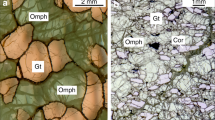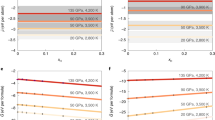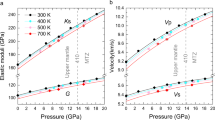Abstract
Arising from: X. Huang, Y. Xu & S. Karato Nature 434, 746–749 (2005); Huang et al. reply
The suggestion that the transition zone of Earth's mantle (410–670 km in depth) is enriched in water is of great possible significance to the geodynamics and geochemistry of Earth's interior, as well as for the role of the mantle in the global water cycle1. Huang et al.2 compare the effect of water on electrical conductivities of transition-zone phases to electromagnetic and magnetotelluric soundings of the mantle beneath the North Pacific3 and conclude that the transition zone contains between 1,000 and 2,000 p.p.m. of water, which is considerably more than the 50–200 p.p.m. present in the upper mantle4,5,6. This conclusion is predicated on the assumption that the transition zone is relatively oxidized, but in fact fairly reduced conditions are more likely7,8. Here I show that if the transition zone is reduced, high conductivities can be explained without the requirement for large enrichments of water.
Similar content being viewed by others
Main
The experiments of Huang et al.2 were done in the presence of metallic molybdenum (Mo), meaning that the oxygen fugacity was at or below the buffer defined by coexistence of Mo and MoO2, which produces an oxygen fug-acity similar to that defined by the coexistence of iron metal and wüstite (Fe1−xO). However, Huang et al.2 recognize that the electrical conductivity of mantle minerals may be critically dependent on oxygen state and assume that the oxygen fugacity of the transition zone of the Earth is similar to conditions imposed by the coexistence of nickel metal and NiO, which is about four orders of magnitude more oxidizing than their experiments. Accordingly, they correct their measurements to account for this difference, using a plausible but unverified model for the relation between conductivity and oxygen fugacity in hydrous wadsleyite and ringwoodite. In contrast, the high propensity of transition-zone silicates, wadsleyite, ringwoodite and majorite to incorporate Fe3+ suggests that Earth's transition zone is quite reduced, with oxygen fugacities similar to or lower than the iron–wüstite buffer7,8. Therefore, it is plausible that the conductivity measurements made by Huang et al.2 may be applied to the transition zone without significant correction for oxygen fugacity.
Figure 1 compares inverted conductivity profiles for the North Pacific3 with model profiles constructed from equation (1) of Huang et al.2, which is derived from uncorrected measurements. Reasonable matches to the inverted profiles are found for 100–300 p.p.m. of water. Such values for the water content are comparable to those in the upper mantle that have been deduced from the geochemistry of mid-ocean-ridge basalts4,5,6.
Lines are for wadsleyite (410–520 km) and ringwoodite (520–670 km) calculated from equation (1) and the parameters in Table 1 of Huang et al.2 for 100, 200 and 300 parts per million (p.p.m.) H2O. The temperature is assumed to increase from 1,825 to 1,900 K between 410 and 670 km. The grey shaded region represents the range of conductivities deduced from three different inversions of conductivity profiles of geoelectrical sounding and magnetotelluric response function data for the North Pacific3. The conductivity profiles derived from experimental data are appropriate for oxygen fugacities similar to the Fe–Fe1−xO buffer.
The conductivity models in Fig. 1 and in Huang et al.2 are not corrected for the effects of grain size or secondary phases. Consequently, some uncertainty remains in relating laboratory measurements to the inverted conductivity structure of the mantle transition zone. But if the measurements of Huang et al.2 give a good approximation of the effect of water on the conductivity in Earth's transition zone, and unless oxygen fugacity at these depths7,8 has been grossly underestimated, the available data do not appear to require significant enrichment of water in the transition zone.
References
Bercovici, D. & Karato, S. Nature 425, 39–44 (2003).
Huang, X., Xu, Y. & Karato, S. Nature 434, 746–749 (2005).
Utada, H., Koyama, T., Shimizu, H. & Chave, A. D. Geophys. Res. Lett. 30, 1194–1198 (2003).
Jambon, A. Rev. Mineral. 30, 479–517 (1994).
Michael, P. J. Earth Planet. Sci. Lett. 131, 301–320 (1995).
Saal, A. E., Hauri, E. H., Langmuir, C. H. & Perfit, M. R. Nature 419, 451–455 (2002).
McCammon, C. Science 308, 807–808 (2005).
O'Neill, H. S. C. et al. in Evolution of Earth and Planets (eds Takahashi, E., Jeanloz, R. & Rubie, D.) 73–88 (AGU, Washington DC, 1993).
Author information
Authors and Affiliations
Rights and permissions
About this article
Cite this article
Hirschmann, M. A wet mantle conductor?. Nature 439, E3 (2006). https://doi.org/10.1038/nature04528
Published:
Issue Date:
DOI: https://doi.org/10.1038/nature04528
This article is cited by
-
Interpretation of Magnetotelluric Results Using Laboratory Measurements
Surveys in Geophysics (2014)
-
A wet mantle conductor? (Reply)
Nature (2006)
Comments
By submitting a comment you agree to abide by our Terms and Community Guidelines. If you find something abusive or that does not comply with our terms or guidelines please flag it as inappropriate.




